On June 22, 2015, The Green-Wood Cemetery’s historian published a blog post titled “New York’s Last Slave.” The story is about the discovery of the resting place of Margaret Pine, who was the last slave of New York State. The blog post tells the fascinating story of the teamwork by the cemetery personnel in finding archival records and the actual monument, albeit small, erected to the memory of Margaret Pine. My own involvement in this process was to transcribe the inscription from blue rubbing paper that was made from the marble marker by the restoration team. The stone was etched with the following words:
MARGARET PINE
a slave to the family of
Wynant Van Zandt
deceased formerly of Little Neck
Long Island
Died August 4th, 1857
Aged 80 years
Serendipitously, on August 3 of this year, I drove by the resting place of Margaret Pine and photographed the site; and as I was posting the photo collage on my Instagram page, it dawned on me that it was 160 years since she was laid to rest in The Green-Wood Cemetery. This fact renewed my interest in Margaret’s story, and so I began searching for her origins.
Rubbing of Margaret Pine’s headstone
As is often the case, information did not match to a “T” between the archival records and what was etched on the monument. The Cemetery’s records indicate that Margaret Pine had died on August 1, 1857 and was laid to rest two days later, on August 3, 1857. Her obituary in The Brooklyn Daily Eagle was published on August 13, 1857 and it read:
Margaret Pine, the last slave in the State of New York, and belonging to the family of Wynant Van Zandt, deceased, formerly of Little Neck, L.I., departed this life on the 4th inst., aged 79 years, she was born in Westchester Co., in the year 1778. She was presented to Mr. Van Zandt by his father, in her comparative infancy.
The minor discrepancy regarding the exact date of death persisted through all the publications of the day. The above was only the first part of the obituary, which was originally published in The Brooklyn Evening Star. The paper was revived in 1841 by Colonel Spooner and by the time of Margaret Pine’s death, it was under proprietorship of his sons, who, among other things, were also publishers of Spooner’s Brooklyn City Directory. No copies of the paper have survived to date, but a copy of the full death notice on Margaret Pine has survived in other, secondary, publications. The earliest known copy of the obituary dates from September 19, 1857 in the issue of Eliakim Littell’s Living Age, complete with all the original typographical errors. It continued:
She was born in Westchester county, in the year 1778. She was presented to Mr. Van Zandt by his father, in her comparative infancy. She remained in the family until the year 1813, at which period, she not being willing to remain in the country, Mr. Van Zandt gave her a release to the following effect:
“The bearer, Margaret Pine is my servant. She has lived in my family from her infancy. She is sober, honest and faithful, but is averse to living in the country. She has my permission to go to New York, for the purpose of going out to service and to receive her wages, until this permission is revoked by me, of which due notice will be given to any person or persons in whose employ she may be. I further declare that it is my wish, and I am now willing to manumit her according to law.
“Given under my hand at Little Neck Farm, this 16th day of September, 1813.
“WYNANT VAN ZANDT
“To all whom it may concern.”
She had acted in the capacity of nurse to the whole family of sons, there having been eleven of them, and six of whom are now living, the eldest being 69 years of age. It is a singular fact, that, having so many children, Mrs. Van Zandt never had a daughter. Margaret refused to be manumitted. She told her master, when he proposed to do so, that he had her services for the best part of her life, and that she wished him to take care of her as long as she lived, and he willingly consented.
Dr. Charles A. Van Zandt, of our city, superintended the whole arrangements of the funeral, and buried her in his family burial-ground at Greenwood. As the Doctor says, she had a black skin, but a pure soul. When she was asked if she would have a physician, she replied, No, that Jesus was her Physician. She was also asked if she had any particular place that she wished her body to be placed. She replied No, it was but little consequence about the body if the soul was safe; said she was tired of travelling, and if it was the will of her heavenly Master to take her home, she was ready and willing to go. She lived like a sincere Christian, and died like one, cheerful, and without a struggle, to the last.
—Brooklyn Star
The first question that arises pertains to the identity of Wynant Van Zandt. Who was he? And who was this Dr. Charles A. Van Zandt mentioned in Margaret Pine’s obituary?
According to the Cemetery’s records, on July 31, 1852, Charles A. Van Zandt of Smith and Schermerhorn Streets in Brooklyn purchased Lot 6160 in Section 105 of Green-Wood. Margaret Pine was the first person to be buried in Dr. Van Zandt’s lot, where he would later place the remains of his daughter (Julia Augusta Van Zandt) and in-laws (Reverend Galen Hicks and Sarah Cody).
In 1882, the last person to be buried in Lot 6160 was Caroline L. Pollock, widow of Dr. Van Zandt. According to his obituary, Charles A. Van Zandt died on January 26, 1867. Born on September 18, 1798, he was son of Wynant Van Zandt. He is not buried in Green-Wood, most likely because Dr. Van Zandt was married more than once, and it is possible his remains now rest with those of his parents, or his first wife, Catherine Ann, who died in 1825.
The Van Zandt family has long been connected to the history of New York and its vicinities, but this is not the place to retell the full genealogy of this family. It is only important to note that the first name Wynant has been carried by every generation of the Van Zandts since 1682.
Wynant Van Zandt (Dr. Van Zandt’s father) was born on August 11, 1767. He was son of Wynant Van Zandt (1731-1814) and Jane Colgen (1729-1777), and died on November 1, 1831. Throughout his adult life, he was known as Wynant Van Zandt Jr., despite the fact that his grandfather was also Wynant Van Zandt; it is for this reason that some genealogists consider him as Wynant Van Zandt III. For the sake of consistency, and in order to avoid any confusion, I will refer to Wynant born in 1765 as Junior, and his father, born in 1731, as Senior.
If all the information in Margaret Pine’s obituary is correct, then her original owner was Wynant Van Zandt Sr. (1731-1814), who “presented” her to his son, Wynant Van Zandt Jr. (1765-1831), “in her comparative infancy.” This is supported by the fact that it was Van Zandt Jr. who in 1813 resided at Little Neck, New York (currently a Queens Borough neighborhood), as Margaret Pine’s obituary states “Given under my hand at Little Neck Farm, this 16th day of September, 1813.” That year, Van Zandt Jr. purchased a tract of land in Little Neck, Queens County, where he would live for the remainder of his life. Van Zandt Jr. was buried within the vault of Zion Church, which was established in 1830 on the land he donated.
Portion of Wynant Van Zandt Sr.’s Will, New York County Surrogate’s Court, dated November 1, 1814 (ancestry.com)
What is not clear, though, is how the senior Van Zandt obtained Margaret Pine, who was, according to all records, born in Westchester County, New York. The Senior was born, raised, resided, did business, and died in the City of New York (currently Manhattan). In fact, on March 9, 1811, he wrote, “I Wynant Van Zandt Sen’r of the City County and State of New York […] make and ordain this my last Will and Testiment.” In his will, Van Zandt Sr. devised all his real estate properties between his heirs, his son Wynant Van Zandt Jr. being the largest beneficiary. He also added, “And my body I desire may be decently put into my own vault in the City of New York.” The vault referred to in his will was located within the burial grounds of Trinity Church. So far as records indicate, Van Zandt Sr. was always associated with New York County, and appears to have no direct connection to Westchester County.
On November 1, 1814, five days before he perished, Wynant Van Zandt Sr. made several amendments to his will. Among the changes he made regarding division of his real and personal estates, he also added, “I also direct my Executors to manumit my Negro slave Jane and I give to my son Wynant Van Zandt Junior my two Negro boys until they respectfully arrive at the age of twenty eight years.” So, if Margaret Pine was manumitted by 1813, why was her name (or any others) not mentioned in the 1811 will?
The question as to when exactly the Senior “presented” Margaret Pine to his son is still unclear. Or did in fact Margaret Pine come to Wynant Van Zandt Junior from his father as the obituary suggests? What if Dr. Charles A. Van Zandt wasn’t actually correct in his information provided for the obituary? After all, in 1813, at the age of 15 years, the future Dr. Van Zandt had just joined the military service, and although he may have known about the manumission of Margaret Pine, he may not have been correct in his knowledge of her being previously owned by his grandfather, Wynant Van Zandt Sr. Let us look elsewhere for possible answers.
In 1788, Wynant Van Zandt Jr. (1765-1831) married Maria Allaire Underhill (1766-1851), “a daughter of Israel Underhill, of Westchester county, who was “lord mayor” of Westchester Co. before the old Revolution.” Israel was born in Westchester County, New York on September 10, 1732 to Nathaniel Underhill and Mary Hunt. On March 4, 1761, Israel Underhill married Abigail, daughter of Anthony Lispenard and Maria Melbourne, in New York’s Trinity Church.
The Underhill family is well recorded in various publications. In 1892, The Underhill Society of America was founded in Brooklyn, New York, and in 1932, the first four volumes of the “Underhill Genealogy” were privately published by Myron Charles Taylor in the interests of the Society. On page 120 of Volume II of “Underhill Genealogy” I find the following:
Names of slaves owned by Israel Underhill copied from a family record in the Van Zandt family Bible. Mary Allaire, his daughter, married Wynant Van Zandt and these slaves were presented to them by her father:
Charles Pine.
Margaret Pine, died 83 years, buried Greenwood.
Ceasar, born Oct. 10, 1792.
Elsy, died Jamaica, L.I., Feb. 5, 1864, 89 years.
Questions arise as to the origin of the Van Zandt family Bible: who created it? when was it created? what was source of information for the Bible? and where is it now? There is a “Van Zandt Family – Bible Record” located in the Archives and Manuscripts Division of the New York Public Library, but alas, items within this set of records pertain mostly to other families married into the Van Zandts.
Margaret Pine’s age was listed as 83 years old in the Underhill publication, which is only a minor discrepancy. The 1932 book does not explain anything else about the slaves owned by Israel Underhill, but this information confirms the hypothesis about Dr. Charles A. Van Zandt’s poor knowledge of the origins of Margaret Pine.
Portion of Israel Underhill’s Will, Westchester County Surrogate Court, dated January 10, 1803 (ancestry.com)
On January 10, 1803, Israel Underhill did “make and declare this my last Will and Testament,” which was probated on May 13, 1807 in Westchester County, New York. After the division of his real estate properties among his heirs, Israel declared, “I give and bequeath to my beloved Wife Abigail my Negro wench Peg […] I also give to my Daughter Maria A. Vanzant my Negro man Charles […] it is also my Will after my desease that my Negro man Sam be free if my Executors think him capable of Getting his living.”
Israel Underhill died on September 23, 1806. His wife, Abigail, died on February 3, 1806, and it is likely for this reason that Margaret, who was recorded as “Peg” in Israel’s will, was given to his daughter, Maria Van Zandt. But what isn’t clear is how Israel Underhill’s daughter Maria obtained the other two slaves, Ceasar and Elsy, as was recorded in the Van Zandt family bible. Also, when was the surname Pine adopted? And who was Charles Pine?
According to the second census of the United States conducted in 1800, Israel Underhill owned five slaves. This would account for all the individuals, namely Charles Pine, Margaret Pine, Ceasar and Elsy, who were presented to Maria A. Van Zandt, and Sam, who was freed. Perhaps sometime between 1800, when the census was enumerated, and 1803, when Israel wrote his will, Ceasar and Elsy were given to Maria A. Van Zandt, as no other records can be located indicating otherwise.
As for Margaret Pine, after 1813, when Wynant Van Zandt Jr. wrote her permission letter, she must have moved to New York to find employment in the city. Unfortunately, her whereabouts cannot be traced to any exactitudes because it was not until the 1850 US Census when each individual within a household was listed separately. Before then, spouses, children, or other relatives of the head of the house, let alone slaves, former slaves, or servants, were not listed in Federal Census records.
In the seventh census of the United States, on July 16, 1850, Margaret Pine’s name was enumerated among the “Free Inhabitants” of the Eighth Ward in the city of New York. And in June of 1855, when the New York State Census was enumerated, I find her at the same “Eighth Ward of the City of New York in the County of New York.” Margaret Pine was living by herself at 72 Thompson Street until the day she died. Most of her neighbors were of African-American descent born in Connecticut, Pennsylvania, New Jersey, New York, and Virginia, but there were also immigrants from Germany, Ireland, and England who inhabited Thompson Street.
And so it was that Margaret Pine was born in 1778, the same year when Israel Underhill served in New York militia as Ensign in the 3rd Regiment. She was born two years after the signing of the Declaration of Independence, wherein the paradoxical phrase “all men are created equal” somehow made sense for men, who fought against the English oppressors and yet owned slaves. For three decades, Margaret was property of the Underhill family, whose descendants still walk the face of this earth. One of them, with whom I had corresponded, the “contrast of religious faithfulness, patriotism and slave holding” is both fascinating and disturbing.
Margaret Pine’s marble marker
It is important to note here that it is a misnomer to call Margaret Pine “the last slave in the State of New York.” At least for me, it doesn’t make sense, as I researched her story. Even if she supposedly refused to be manumitted in 1813, by 1827 she would be free as the Gradual Emancipation law allowed. The Fifth Census of the United States conducted in 1830 recorded 76 slaves still in existence in New York State. That year, no slaves were reported in the Kings or Queens counties, where Margaret Pine would possibly be living. Whatever the reasoning was for calling Margaret Pine “the last slave of New York” certainly she could not be so at the time of her death, for she was living on her own as the 1850 US and 1855 NYS census records show.
January 16, 2021
A nudge from a colleague prompted further look into our story. Following comments below, I looked further into the Underhill family.
Probated on December 19, 1775, Nathaniel Underhill Jr.’s will was written on “the 25th Day of February 1775” in the presence of Joseph Avery, Samuel Embru, and Dorothy Underhill. The executors appointed were “my sons Nathaniel, Bartow & William.” In the excerpt of the will, I find the following in regards to the fate of his slaves:
Also I order & allow that my Wife shall have the yus [sic] of my Negro Man Named Pine as long as she remains my Widdow [sic] & the liberty to Keep a Cow and hors [sic] on my said Farm during said time & the liberty to Cut firewood on my said Farm for hur [sic] use & hur [sic] Negro during said Time on any part of my Farm whear [sic] she pleases all things, things I gave her & allow hur [sic] in lieu of her Dower.
Portion of Nathaniel Underhill Sr.’s Will ,Westchester County Surrogate Court, dated February 25, 1775 (ancestry.com)
To avoid confusion between the similarly named men, it is important to note the following. The first Nathaniel in the Underhill family was born on December 22, 1663 in Nassau County, NY to John Underhill who came from England; he died on November 10, 1710 in Westchester County, NY. It would be proper to call him Nathaniel Underhill Senior (1663-1710); his wife was Mary Ferris (1662-1715). Their son Nathaniel, born August 11, 1690 and died November 27, 1775, would be the Junior; his wife’s name was Mary Hunt (born July 22, 1692). Nathaniel Jr. and his wife had ten children that included Israel Underhill of our story, and Nathaniel Underhill III (1723-1784).
Further in the will, I read the following:
I gave to my said Son Israel Underhill after my Wifes decease my Negro Man Named Pine & also I gave to my Son Israel Underhill his heirs and assigns forever my Negro Wench Hugor & boy Charles my Devises to my said Son Israel Underhill to also on Conditions that he his heirs & assigns Do Promit [sic] & Allow my Wife Mary to have and enjoy the liberty & Previleges [sic] I have Given hur [sic] in this Will.
Portion of Nathaniel Underhill Sr.’s Will ,Westchester County Surrogate Court, dated February 25, 1775 (ancestry.com)
As his will states, Nathaniel Underhill Junior had three slaves at the time of his death:
- Man Named Pine
- Wench Hugor
- boy Charles
The Underhill Genealogy does not record the date of death for Mary Underhill, but she was alive when her husband devised his will in 1775. Certainly, upon her death, Mary’s slaves would be given to her son, Israel Underhill. As for the origin of the name, it would appear that Pine was a first name, which eventually turned into a surname. Is it possible that the boy Charles was child of Pine and Hugor? If so, it would allow for the origin of Charles Pine (as in Charles son of Pine) mentioned in Israel Underhill’s will, above. If I am allowed the conjecture of Pine and Hugor being parents of Charles, I may also suppose that they had a daughter born to them in 1778, who would be named Margaret, the main subject of our story. Thus, I can hope to have the parents of both Charles Pine and Margaret Pine.
Therefore, with some degree of certainty, I state that Margaret was born in 1778 when her parents, Pine and Hugor, were slaves of Israel Underhill. Throughout her life, she would be known as Margaret daughter of Pine, or simply Margaret Pine. In 1806, at the age of 28, Margaret became the property of Maria Van Zandt, daughter of Israel Underhill. On September 16, 1813, Wynant Van Zandt Jr., husband of Maria, when he moved to Little Neck in Queens County, manumitted Margaret Pine. As late as 1850, I find Margaret Pine living by herself in New York among the free inhabitants of the city. Upon her death in August of 1857, Margaret Pine found her resting place in The Green-Wood Cemetery.
~*~*~
But what of Ceaser, who was recorded in the Underhill Genealogy as born on October 10, 1792? Would he be known as Ceaser Pine or Ceaser Van Zandt? I am hoping to return to him at later time.
In the meantime, with the help of a commentator below, I was able to find marriage of Elsy Van Zandt to Cato Bates. Perhaps, in the future, I will attempt to track down the resting place of Elsy Bates, as the Underhill family bible does provide her date of death.
CHRONOLOGY
- 1690 August 11, Nathaniel Underhill Jr. born to Nathaniel Underhill Sr. and Mary Ferris
- 1710 November 10, Nathaniel Underhill Senior dies in Westchester County
- 1711 April 19, Nathaniel Underhill Jr. marries Mary Hunt
- 1723 August 31, Nathaniel Underhill III born to Nathaniel Underhill Jr. and Mary Hunt
- 1730, Wynant Van Zandt Senior is born to Wynant Van Zandt (1683-1763)
- 1732 September 10, Israel Underhill born to Nathaniel Underhill Jr. and Mary Hunt
- 1761 March 4, Israel Underhill marries Abigail Lispenard
- 1766 March 19, Maria Allaire born to Israel Underhill and Abigail Lispenard
- 1767 August 11, Wynant Van Zandt Junior is born to Wynant Van Zandt and Jane Colgen
- 1775 February 25, earliest record mentioning Pine, Hugor, and Charles in will of Nathaniel Underhill Jr.
- 1775 November 27, Nathaniel Underhill Junior dies in Westchester County
- 1775 December 19, Will of N. Underhill Junior probated; Pine, Hugo and Charles devised to Israel U.
- 1778, Margaret Pine is born to (possibly) Pine and Hugor, slaves of Israel Underhill
- 1784 January, Nathaniel Underhill III dies (his will dates March 29, 1783, but probated Feb. 13, 1784)
- 1788 June 21, Maria Allaire Underhill marries Wynant Van Zandt Jr.
- 1806 September 23, Israel Underhill dies in Westchester County
- 1807 May 13, Will of Israel U. probated; Margaret Pine given to Maria A. Van Zandt
- 1813 September 16, Margaret Pine is manumitted by Wynan Van Zandt Jr.
- 1814 November 6, Wynant Van Zandt Sr. dies in New York County
- 1831 November 1, Wynant Van Zandt Jr. dies Queens County
- 1850 July 16, Margaret Pine listed among Free Inhabitants of Eight Ward in the City of New York
- 1857 August 1, Margaret Pine dies in Brooklyn, NY
A note about Nathaniel Underhill III (1723-1784) and his slaves. In his will, which was written on March 29, 1783, Nathaniel devised his slaves to the following persons:
- I give and bequeath unto the said Thomas McLeroth one half of all my household furniture, my negro woman Tempe and her child
- I give and bequeath unto my above mentioned Nephew Anthony Lispenard Underhill my negro men Slaves Tom, Dick, and Cull
- I also give the said Gloriana Underhill, my Negro girl Nanny
- I give to my three negro Slaves Abraham, Phillys and Peggy their absolute and intire [sic] freedom from any Servitude to any person or persons whatsoever and this I do in consideration of their faithfull [sic] Services to me during my life time. I recommend it to them to be Sober and industrious and to get their living honestly
From his will, I learned that Nathaniel had 9 slaves before he died. To follow up with the comment below about Nathaniel’s “posting a notice for a run away ‘wench’ named Peg,” I discovered something peculiar. I could not find the exact date for the runaway notice, but I think it must have happened after Underhill wrote his will. Before his death, Nathaniel wrote a codicil to his will making the following amendment:
And Whereas in the body of this will, I have given a Sertain [sic] wench caulled [sic] Pegg free at my deces [sic] and the Said negro wench caulled [sic] Peggg having behaved so contrary to the rule of a Good Servant that I do order my Executors by virtue of this Coddelsill [sic] to Sell the Said negro Pegg as a pat of my mouvable estate.”
Another note of importance, which I cannot ignore is the 1755 Census of Slaves, for the Borough of Westchester in Westchester County of New York. There is a Nathaniel Underhill listed among the slaveholders. The list was compiled by John Hitchcock, clerk of Captain Joshua Hunt, who was in charge of the borough. Nathaniel Underhill’s slaves included Peter Pinna (male) and Easter (female). This could be either Nathaniel Underhill Jr. (1690-1775), or his son, Nathaniel Underhill III (1723-1784), but since I cannot yet identify which of the Nathaniel’s this is, I am placing this source here for the time being.
On August 11, 2017, the search for the origins of Margaret Pine lead me to the New York Public Library. Among almost 11,000 collections, the Archives and Manuscript Division of the library holds the papers of Wynant Van Zandt Jr. It is a modest collection comprising of only two boxes of letters dating primarily between 1804 and 1807. I did not find any traces of Margaret Pine within Van Zandt Jr.’s papers, nor any mention of other slaves owned by the family. However, among the ink stained and foxed linen and cotton letters, one particular item stood out. It had nothing to do with the individual of my interest, but the content of the letter had much to do with the subject of this work. It was a letter dated from 1805 and addressed to Wynant Van Zandt Jr. at the time when he held the office of alderman.
Wynant Van Zandt Jr. papers, Archives and Manuscripts Division, New York Public Library, Astor, Lenox and Tilden Foundations.
W. Van Zandt Jr. Esquire
Sir
Not being so well acquainted with any other Magistrate of the City, I beg leave to trouble you with an application in behalf of an infirm Black free Woman whose situation is such as renders it necessary for her to be placed upon the Poorhouse istablishment. Her name is Molly Duncan aged about 74 Years. She has been free as the date of her Certificate of Manumission will show 5 Years. I took her into my house in time of the fever when she knew not where to go and finding that she is a great incumbranse to me will be much obliged to your Sirs if you will be so kind as to procure her a place in the Poor house, or direct me in the pursuit of such measure as are necessary to accomplish that end.
With Esteem I Remain
Yours respectfully
M. Oothout
Monday morning, 25th Nov. 1805
The author of the above letter was most likely Magdalena Van de Water, widow of John Oothout, who died on September 20, 1804 at his residence in New York. John Oothout was elected Alderman in 1802, along with Wynant Van Zandt Jr., hence M. Oothout’s reference in the letter to “any other Magistrate of the City”. John and Magdalena Oothouts had five children, two of whom died in their infancy, and after his demise, Mrs. Oothout was left with three children, aged 17, 15 and 8. Magdalena was born in 1754 to William Van de Water and Elizabeth Hendricks. It is unknown as to what happened to Molly Duncan mentioned in the letter, and although the Oothout family were not entirely destitute, a clue lies in the letter as to possible reason for “incumbranse”. Magdalena Oothout wrote, “I took her into my house in time of the fever,” which must mean sometimes before 1803.
In 1793, the city of Philadelphia was hit by a yellow fever epidemic, which traveled along the coastline to the busy ports of New York. The fever “reached epidemic proportions three times: in 1795, 1799, and 1803 claiming thousands of lives over the course of its presence in NYC.” It is about this time when city authorities established the first Board of Health Commission, the chairman of which, in 1798 and 1799, was John Oothout himself. It is possible Magdalena Oothout lost two of her children in the epidemic, and after demise of her husband, who may have also succumbed to the fever, she was fearful for herself and other members of the family. Magdalena Oothout died on April 10, 1826, living to the ripe age of 72 years; her body rests in Vault 10 at the New York City Marble Cemetery. One only hopes that Molly Duncan had also found her proper resting place, wherever that may be.

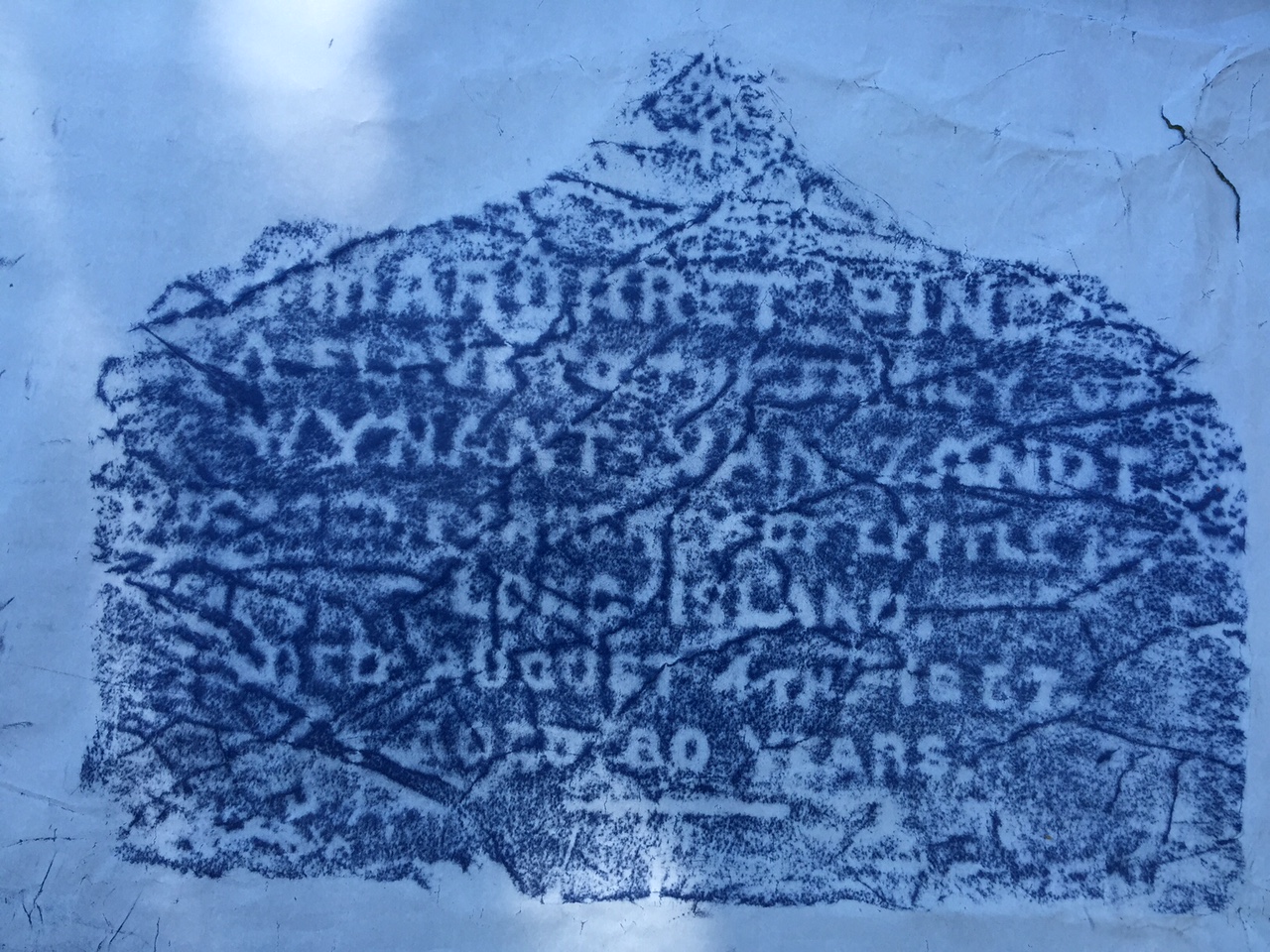
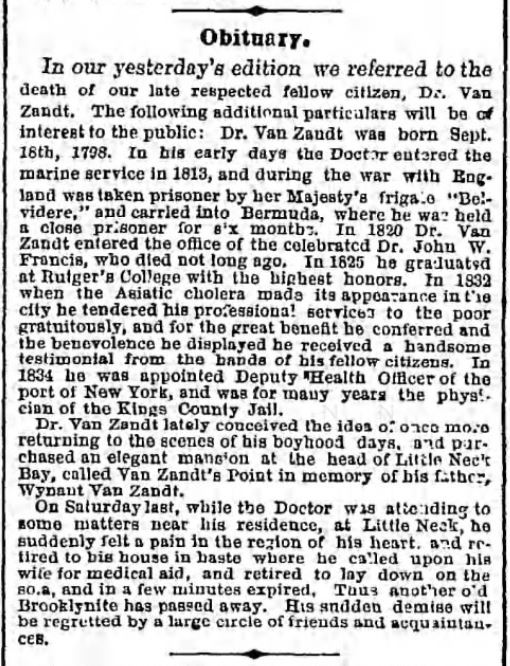


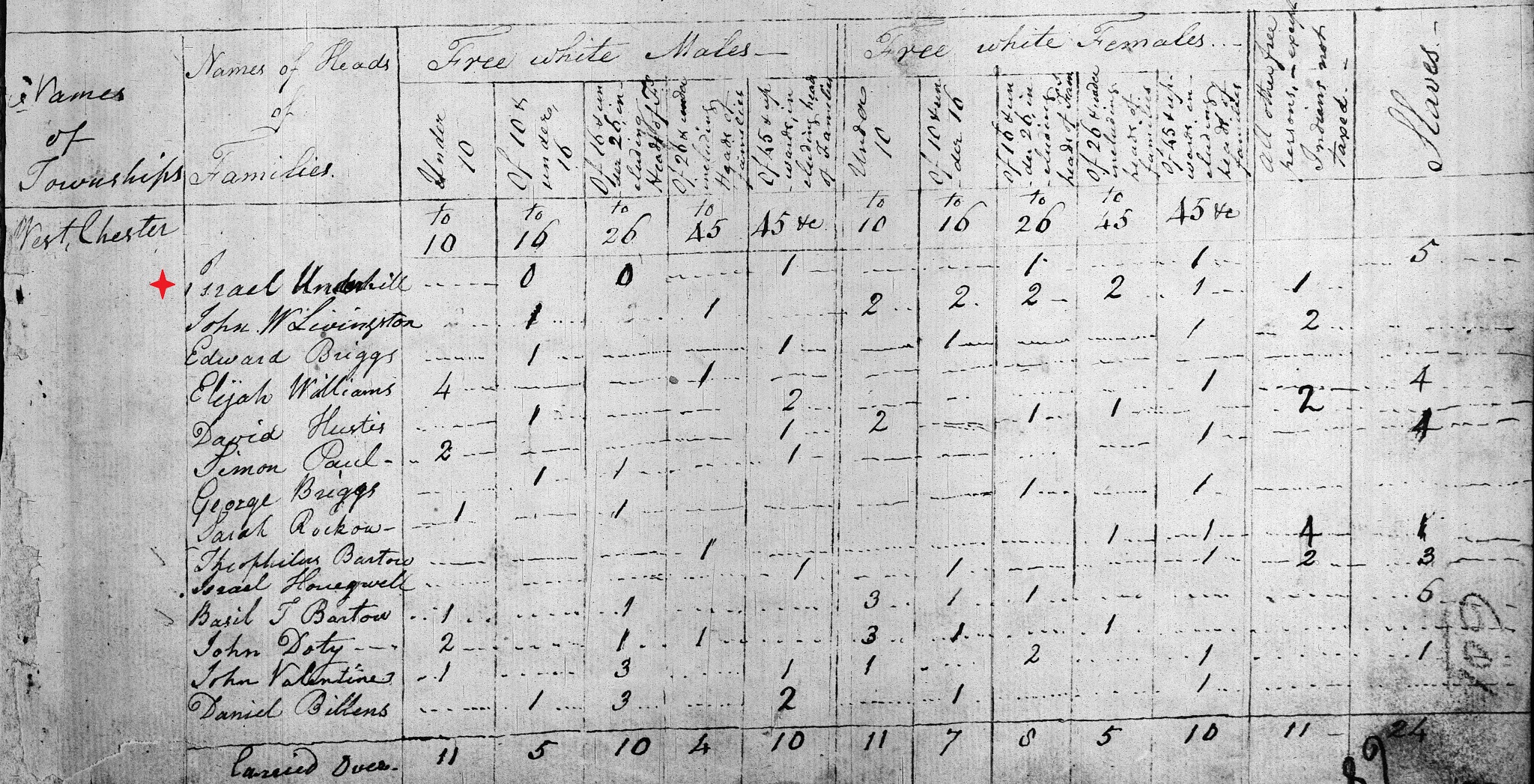
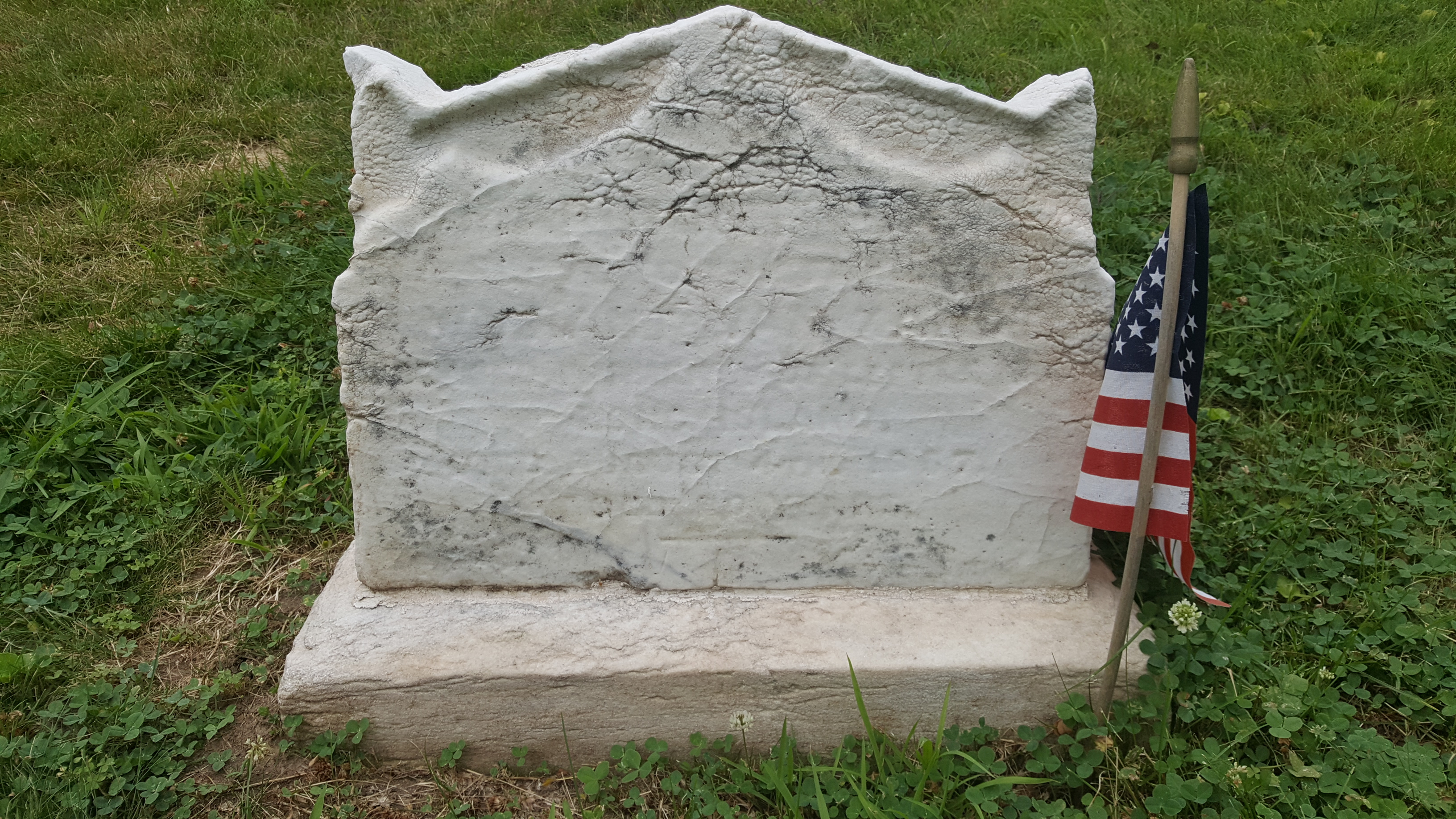



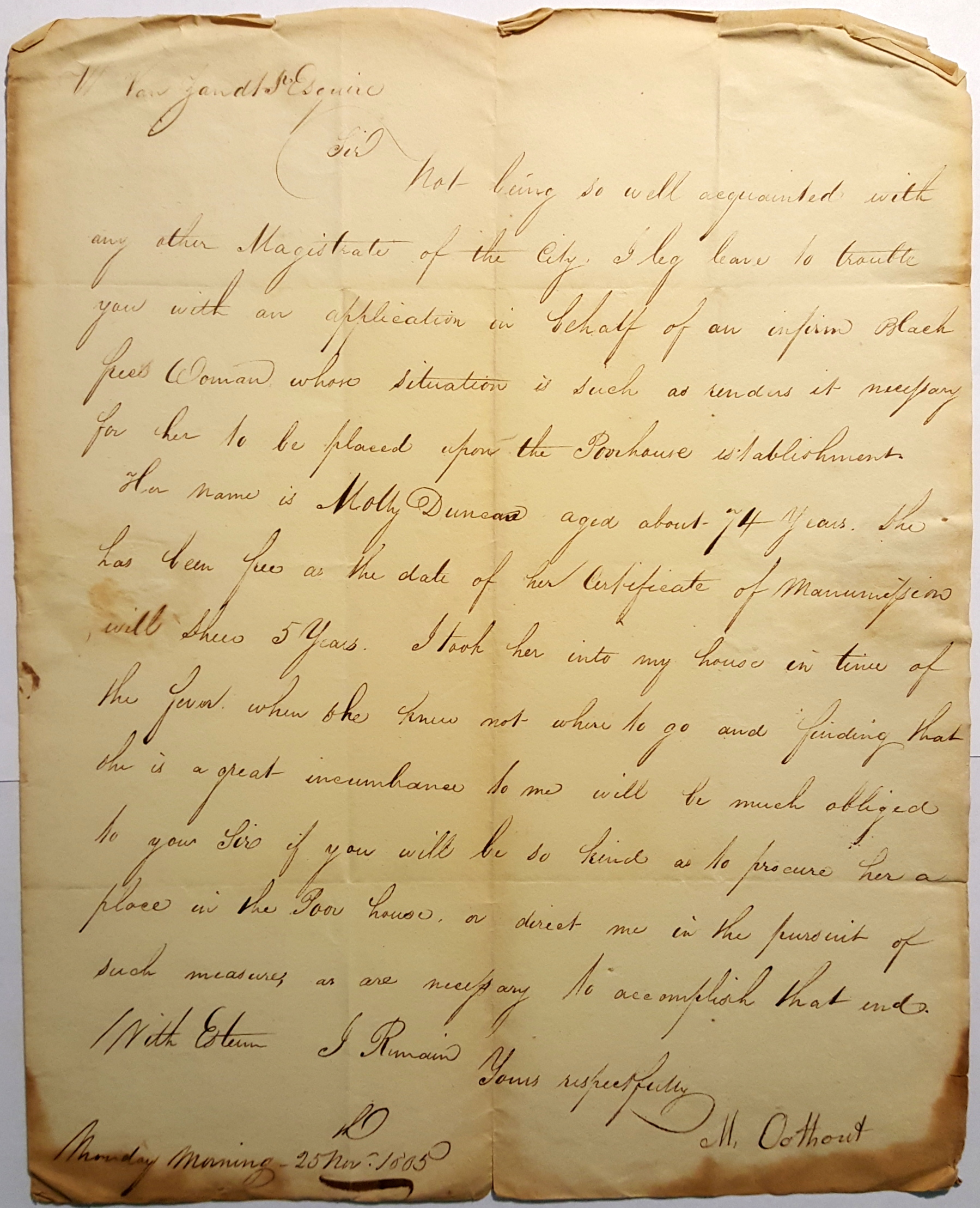
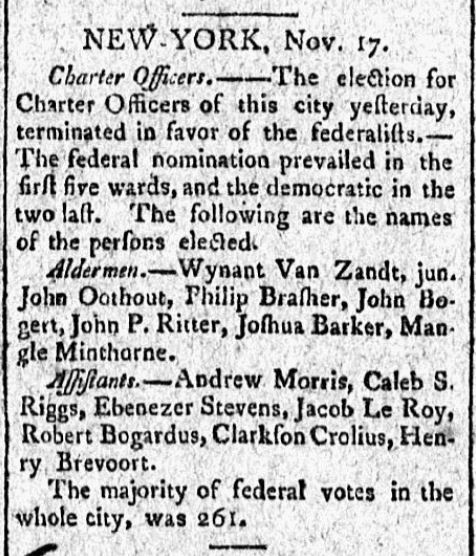
Israel Underhill’s father, Nathaniel Underhill, in his will (dated Dec 19 1775) bequeaths to his wife Mary Hunt Underhill, his “negro man “Pine”” This could be where the name originated. Israel’s brother, Nathaniel is also listed in the book In Defiance, posting a notice for a run away “wench” named Peg. I think the Underhill connection may provide you with some pathways to Margaret and her story.
I think elsy named in the will is Elsey Van Zants who married Cato Bates in 1813. Listed in the book “origin and history of Grace Church”